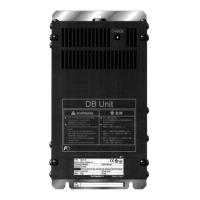9.2 CANopen Communication
9-36
(4) Communication example
This section describes the communication example when running the inverter by controlling the DSP 402 state
machine. In the description, PDO No.2 is used. Besides, the following conditions are assumed:
• Node ID of inverter (inverter function code y21 / o31 of this communication card) =1
• Transmit PDO Nos. 1 and 3 are invalid.
That is, Index 1800 sub1=0x80000181, Index 1802 sub1=0x80000381
• Other CANopen’s objects are set to default
• Inverter function code y98 =3
The format of PDO No.2 is as follows:
■ Receive PDO (from master to inverter)
COB-ID Byte0 Byte1 Byte2 Byte3
0x301
Controlword
(L byte) (H byte)
vl_target_velocity
(L byte) (H byte)
■ Transmit PDO (from inverter to master)
COB-ID Byte0 Byte1 Byte2 Byte3
0x281
Statusword
(L byte) (H byte)
vl_control_effort
(L byte) (H byte)
1) If Start_Remote_Node service is received, the inverter moves to Operational state to enable the PDO
communication. At the same time as the state changes, the transmit PDO No.2 responds as follows: The
lower byte of Statusword (Byte0, 1) = 50 indicates that the state machine is in the state 2.
Transmit PDO
(from inverter to master)
COB-ID
Byte0 Byte1 Byte2 Byte3
0x281
50 02 00 00
2) Here, change the state from 2 to 3. Transmit the data below to Controlword (Byte0, 1).
Receive PDO
(from master to inverter)
COB-ID Byte0 Byte1 Byte2 Byte3
0x301 06 00 00 00
As shown above, the transmit PDO responds as follows. The lower byte of Statusword (Byte0, 1) = 31
indicates that the state is 3.
Transmit PDO
(from inverter to master)
COB-ID Byte0 Byte1 Byte2 Byte3
0x281 31 02 00 00
3) Next, change the state from 3 to 4. Transmit the data below to Controlword (Byte0, 1).
Receive PDO
(from master to inverter)
COB-ID Byte0 Byte1 Byte2 Byte3
0x301 07 00 00 00
As shown above, the transmit PDO responds as follows. The lower byte of Statusword (Byte0, 1) = 33
indicates that the state is 4.
Transmit PDO
(from inverter to master)
COB-ID Byte0 Byte1 Byte2 Byte3
0x281 33 02 00 00

